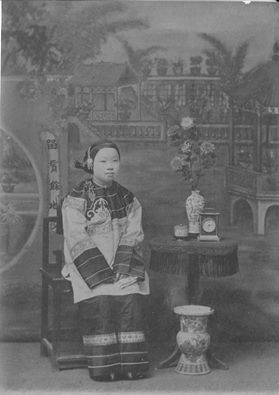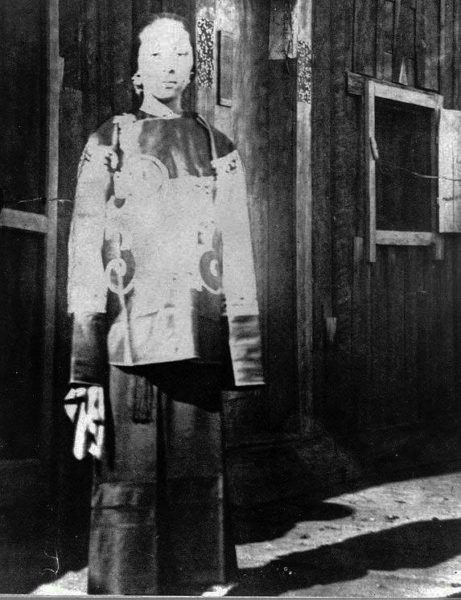I returned to tales of the ‘wild west’ and pioneers of the frontier looking for women who may have been cut out of the history books because of their sex, culture, and race. There are no shortage of stories romanticizing the time period, the seeming lawlessness, and the rugged criminal turned hero. They distract us from the many atrocities that were committed as east coast colonists pushed westward, warring with native peoples and decimating the land in order to claim for their own everything between the Atlantic and Pacific oceans. The harsh and turbulent conditions meant that people had to contend with so much more than we can imagine, sometimes rising in fame because of their business savvy, their integrity, and their resolve. China Mary was just such a person.
Except that she was multiple people. During the time of the Chinese Exclusion Act, and the following legislation that prohibited immigration of Chinese people to the United States, racist actions towards Chinese people in the United States ranged from massacre to seemingly polite acts of diminution (“Chinese Exclusion Act,” 2021). Prior to and despite the prohibitions on immigration from China, many people living in China headed for the U.S. to escape facing violence from civil was between 1840s and 1860s, unemployment, famine and overpopulation of coastal cities. Chinese men often immigrated to the U.S. without their wives and some families in China decided to sell their daughters into prostitution oversees to both avoid starvation and provide the girls with the opportunities a new country may provide (Waggener, 2021). While looking up more information on the woman in Tombstone known as China Mary I came across a couple more, in Wyoming and Alaska, and discovered that Chinese people were often called China Mary or China John to save white people the trouble of learning their real names. I cannot adequately express how much this bothers me. To deny someone their name is ultimately demeaning and terribly cruel; it is an erasure. There are probably thousands of China Marys and China Johns completely lost to history by design. Today I’m going to explore the lives of Sing Choy, Ah Yuen, and Mary Bong, likely not their real names.

Qui Fah or Mary Bong 1880-1958
The woman who would become known as China Mary or Mary Bong in Sitka Alaska was born in Shiqi (Shek Kee 石岐) in Zhongshan 中山 county (“Mary Bong or China Mary,” 2019). From her own reporting to a newspaperman in 1935, she ran away from home at the age of 13 and headed for the United States. Aware of the immigration restrictions facing her, she arrived Canada and stayed in Vancouver until she made friends with Gee Bong, a Sitka resident on a business trip. Her reasons for marrying at the age of 15 were practical, as she recounted to the newspaperman: “I learned that if I were married to a man who had his immigration papers I could get into the U.S. as his wife. I liked my new Chinese friend from Alaska so I married him” (DeArmond, 1994). She helped her husband with his Bakery and Restaurant, where she was dubbed China Mary.
By her own report, she learned the Tlinget language of the native peoples who lived around Sitka, and served as a midwife to them. Though not the only option for native women, as she intimated in her interview, the relationships she had built up with a few of the Tlinget women may have made her the most attractive option of obtaining help, in comparison to the white male dominated clinics in the area (DeArmond, 1994).
Her husband died in 1902 and left some little monies behind for Mary Bong and her two daughters. She leased the restaurant equipment for a while before selling it off and began to build a house for herself (DeArmond, 1994). She also worked as a house maid, and established a laundry business out of her house. In 1903 she married Sing Lee, a man she had met through her first husband’s restaurant business. She sent her eldest daughter, Kathryn, to school in Victoria not long after her second marriage. On the way there, Kathryn became ill and died.
With her youngest daughter, Anna, Mary Bong followed her second husband to Chicago to provide business for the recent mining boom. There, through Sing Lee’s business dealings, she met Fred Johnson, a recent Swedish-Finn immigrant (DeArmond, 1994). She divorced Sing Lee in 1909, and would not acknowledge this six year relationship in future interviews. She and Johnson returned to Sitka and embarked on many businesses. They ran Mary Bong’s laundry together before obtaining a property to start a mink ranch. Later they rented an island to establish a fox farm and worked on the trolling boats. By Mary Bong’s own account, she was the first female troller in the area.
When Fred Johnson’s health took a turn for the worse, Anna was living in Anchorage. Mary Bong took a job as matron in Sitka’s federal jail until she was admitted to the Pioneer’s home hospital with a long illness. Anna moved back to Sitka to help her mother recover until in 1958 Mary Bong was admitted again to Pioneer’s where she died weeks later.

Ah Yuen ~1850-1939
Ah Yuen, the woman known as China Mary in Evanston Wyoming, arrived as a young girl in the U.S. from south China around 1863 (Waggener, 2021). Ah Yuen reported to a Works Progress Administration interviewer that she began her journey through the U.S. in San Francisco, traveling through Denver until she arrived in Bear River City, Wyoming Territory in 1868. In the WPA interview, she was described as an unusually beautiful, cheerful, woman who spoke fluent English. She was married by the time she witnessed the ‘Bear River City Riot’ on November 19, 1868 (Waggener, 2021).
Park City, Utah’s China town grew when the first railroads into the city were created, but mostly Chinese labor. Ah Yuen and her husband opened a shop here in the 1880s, weathering the race violence documented in the city until her husband died and Ah Yuen, in her 40s or early 50s, moved to Evanston around 1900.
Evanston was a growing city at this point, with a icing station, brick depot, federal courthouse, and post office. It also had one of the of the few Chinese temples in the U.S. This temple and all of Evanston’s Chinatown burned in 1922, inspiring many of the Chinese residents to leave the city. Ah Yuen stayed on, by this time married to her third husband Lock Long Choong, known as ‘Mormon Charlie.’ In her older age she would regale people with stories of her time in San Francisco, Denver, and Park City. Tourists would pay 10 cents to take her picture with them, which she would use to pay local children for their fish catch from Bear River. She loved to gamble, and, according to her biographer Denice Wheeler, was never fully accepted in Evanston for this, her opium smoking, and her history of prostitution. Though Wheeler reported that everyone knew her and regarded her for her beauty (Weber, 2011).

Ah Chum or Sing Choy 1839 – 1906
Sing Choy, originally from Guangdong province, was the daughter of a Chinese gold miner in California. She and her husband, Quong Gu Kee, ran the Can Can Restaurant in Tombstone (Hung, 2018). She was known as an astute businesswoman and was trusted by both the Chinese and White residents of Tombstone, who used her as a mediator for locating reliable jobs and laborers (Hung, 2018; Craven, 2018).
As one of the famous residents of Tombstone, the stories surrounding Sing Choy have a bit of legend about them. Stories about her paint a picture of a powerful underworld boss who was as likely to run an honest business as she was likely to procure drugs and prostitutes for people who knew how to ask. She extracted a commission from the pay of the laborers for whom she had found work and invested her monies in restaurants and laundries. She also ran a general store, gambling halls, opium dens, and was said to have provided Chinese prostitutes to those that were looking (Craven, 2018).
In addition to her shrewdness, she was known for her compassion, lending money, standing up for other Chinese people she saw were wronged, and helping out miners who were down on their luck. Most of Tombstone would attend her funeral in 1906 when she died of a heart attack.
Reading
- Chinese Exclusion Act (2021) Wikipedia. https://en.wikipedia.org/wiki/Chinese_Exclusion_Act
- Craven, Scott. (2018) These 8 women changed the face of Arizona. Here’s how they left their marks on history. AZ Central. https://www.azcentral.com/story/travel/arizona/2018/09/10/wild-west-historic-women-americas-old-west/947159002/DeArmond, Robert N. (1994) Around & About Alaska: Notes and Comments by Robert N. DeArmond. Daily Sitka Sentinel. February-March series.
- First Transcontinental Railroad (2021) Wikipedia. https://en.wikipedia.org/wiki/First_transcontinental_railroad
- Griffin, Kristy (2015) China Mary. Sitka History Museum. https://sitkahistory.com/2015/03/china-mary/
- Hung, Louise (2018). AAPI Women in History: China Mary. Global Comment: Where the World Thinks Out Loud. https://globalcomment.com/aapi-women-in-history-china-mary/
- Mary Bong. (2021) Biographies. Genealogy Trails. http://genealogytrails.com/alaska/sitka/bios_01.htm
- Mary Bong or “China Mary” 1880-1958 (2019) CHINESE WOMEN IN THE NORTHWEST . Chinese in Northwest America Research Committee. http://www.cinarc.org/women.htmlDeArmond, Robert N. (1994) Around & About Alaska: Notes and Comments by Robert N.
- Trimble, Marshall (2017) China Mary. True West Magazine. https://truewestmagazine.com/china-mary/
- Waggener, Leslie. (2021) Wyoming’s China Mary. Discover History: The blog of the American Heritage Center. https://ahcwyo.org/2021/02/08/wyomings-china-mary/
- Weber, Christine (2011, February 19). Wheeler reveals the mysteries of China Mary; Washakie County Library hosts evening program. Northern Wyoming Daily News (Worland, WY), 5.
